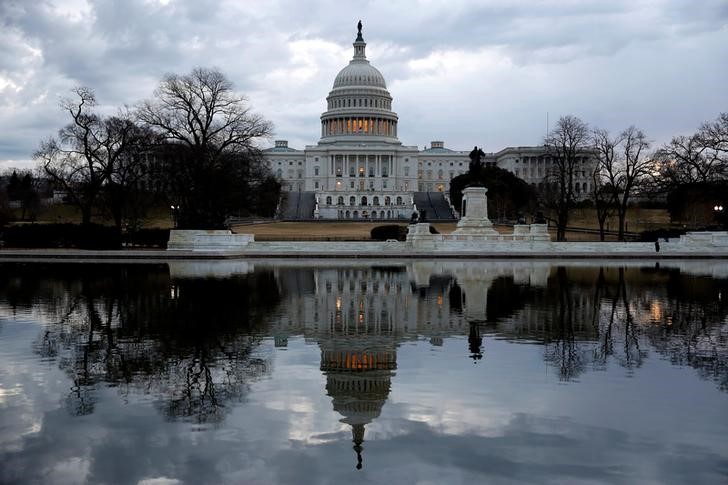 © Reuters. Clouds pass over the U.S. Capitol at the start of the third day of a shut down of the federal government in Washington
© Reuters. Clouds pass over the U.S. Capitol at the start of the third day of a shut down of the federal government in WashingtonWASHINGTON (Reuters) – A partial U.S. government shutdown was widely expected to continue after Congress reconvenes on Thursday, with lawmakers split over President Donald Trump’s demand for $5 billion in taxpayer funding for a proposed Mexican border wall.
The Senate and the House of Representatives were set to meet at 4 p.m. EST on the sixth day of the shutdown and resume debating ways to end it. That will include Senate consideration of a measure already approved by the Republican-controlled House that meets Trump’s wall-funding demand.
For that bill to move forward in the 100-seat Senate, it would need 60 votes. Republicans will control 53 seats in 2019, so they will try to convince some Democrats to back it.
But Democrats largely oppose Trump’s proposed wall. They have offered support for $1.3 billion in general border security funding. It was not clear if some compromise could be struck between that offer and Trump’s demand.
Over the weekend, White House acting Chief of Staff Mick Mulvaney said the White House had made a counter-offer to Democrats on border security. Media reports said Vice President Mike Pence had proposed $2.1 billion in funding.
Trump said on Wednesday, on a surprise visit to Iraq, that he could wait to get his wall funded. Asked how long that wait might last, he said, “Whatever it takes.”
After weeks of failed talks between Trump and congressional leaders, parts of the U.S. government shut down on Saturday, affecting about 800,000 employees of the Departments of Homeland Security, Justice, Agriculture, Commerce and other agencies.
Most of the federal government, which directly employs almost 4 million people, is unaffected. The Defense, Energy, Labor and other departments are funded through Sept. 30.
Even agencies that are affected never totally close, with workers deemed “essential” still performing their duties.
“Non-essential” federal workers at unfunded agencies are on furlough and staying home. Both they and essential employees will not get paychecks after December until the shutdown ends.
The 435-seat House was also set to reopen on Thursday.
“We continue to believe that it is unlikely that Congress will come up with a deal to end the current partial shutdown until well into January,” said financial firm Height Securities in a commentary note on Wednesday.
On Jan. 3, the 2017-18 Congress will be replaced by the 2019-20 Congress and control of the House will switch to the Democrats from the Republicans. At that time, Representative Nancy Pelosi is expected to take over as House speaker.
She has vowed swift action to fully reopen the government. Barring some sort of deal in the interim, House Democrats expect to vote on a funding bill on Jan. 3, said a Democratic aide.
Details of the upcoming House bill were unclear, but it was unlikely to include wall funding, like an earlier Senate measure. If such a bill were to pass the House and again win support in the Senate, it would go next to Trump.
At that point, he could face a politically difficult choice – back down on his full wall-funding demand or veto the bill and single-handedly extend the partial shutdown.
If he chose the latter, putting his personal stamp on the shutdown, Congress might then move to override his veto, but that would take a two-thirds vote in both the Senate and the House, a challenging hurdle for lawmakers.
Source: Investing.com




























